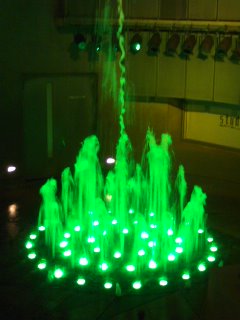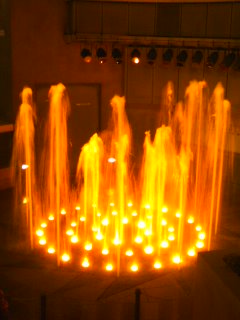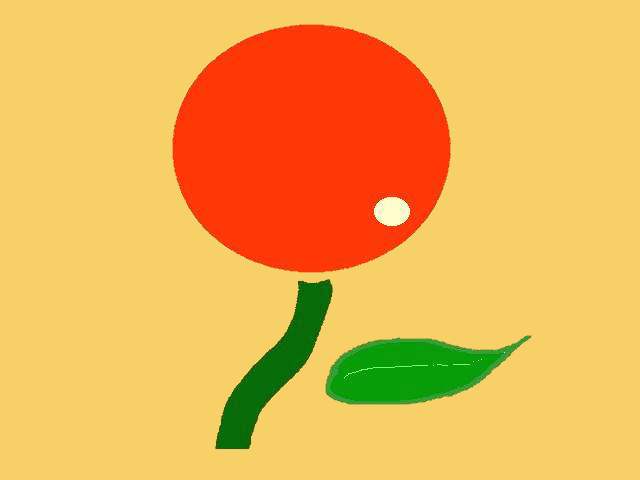After I opened my clinic, I joined the society again ordinary as working 5-6 days a week.
Then how was my health including AD ?
 Though my skin was continuously dry and powdery especially on the arms, true eczemas seldom existed except my hands in winter.
Though my skin was continuously dry and powdery especially on the arms, true eczemas seldom existed except my hands in winter.
I applied petrolatum vaseline on the hand lesions.
I still had itch at night, which made wheals and sometimes made me almost awake, but I could sleep so-so without frequent urination (mostly 0-1 times a night).
When I was busy and deeply tired, a itch increased strong to disturb the night sleep, but I could recover as the tiredness left.
In the first 6 months, I felt it heavy to work every day and the tiredness tended to prolong, then I thought I could be adjusted into the new circumstances.
My lifecycle were as always, taking a bath in the morning, then rest lying in bed, no sports, minimum travels.
It was impossible to enjoy public bathing for me.
But now even if I passed the morning bathing, my skin was all right just having some bearable itch.
I could go out more often in addition to my daily works.
My constitution always raised itch when I was tired.
It began like a short stinging painful sensation at a superficial nerve and I had to shrank to endure.
Then there sometimes arose clear wheal.
The itch was strong when the wheals appeared and ended before they diminished.
All of these process seemed to be reactions concerned neurotransmitters or neural responses.
I thought the man great who named AD as "neural dermatitis".
On the other hand, I rather thought the idea of modern Japanese dermatological authorities who decided "scratching of AD patients should be habits to dissolve their mental stresses" would be an unscientific stale one.
Even if neural reactions were invisible, even if only patients themselves could sense their itches, the itches existed before their scratch should not be ignored.
I had another new symptom which was somewhat embarrassing, a weeping eczema at my both crotches.
I didn't know whether it was due to chafing between the obese thighs and the pubic area or an allergy to the elastic hemmings of my undershorts.
It lasted waxing and waning for about 2 years and was gradually dismissed before I was realized it.
In fact, I became obese probably because postmenopausal metabolic inactivity and late dinners.
I got several kilograms more than when I was deeply sick.
It was mortifying I could not reduce the overweight, however I was still free from diabetes or other metabolic or hormonal disorders.
I could eat everything, But I ate less after I aged over 50.
According to the current of the times, my meals contained more meats and less vegetables.
I also took some nutritional supplements to keep myself energetic enough to fulfill my work.
I ate some sweet confectioneries, too, which was one of my limited pleasures, which did not particularly worsen my skin.
Most symptoms progressed well.
Now I never had postural hypotension since I did not stay in bed long.
About irritated bowel syndrome, I did not suffer severe constipation any more, including no hard small round feces like a rabbit's.
Constant excretions came at least within every three days, almost every day most of the time. I did not suffer severe prolonged abdominal pains.
But I sometimes had a sudden diarrhea or multitude excretions perhaps after nutritional or other allergy elimination sessions of NAET.
It might be a changing process my body adapted to various items which previously had been my allergens.
Now this was all I could remember about problems of my ill health for these 2 years and a half.
There might not be no more need to describe my medical history here.
Yet I have not accomplished to be having nothing to do with Atopic Dermatitis.
Maybe in some day I will write down a sequel here...
At this point, I sum up my whole medical history, with the amount of topical corticosteroids I used.
 ☆My Atopic Dermatitis Story☆
☆My Atopic Dermatitis Story☆
A few months after birth, I had severe seborrheic dermatitis on my forehead ; a sign of atopic constitution.
I loved milk heavily and then hate it ; a sign of hidden food allergy.
During elementary school, my skin sometimes went dry with itch.
In junior high school, my skin got scaly in many places with constant itch.
I applied topical strong corticosteroids in case of severer symptoms, but most of the time, I just scratched and left as they were.
Total amounts of topical corticosteroids used would be 30g or so.
Then in a medical university, I was fairly active in a school tennis club and the progress was almost good.
During a training camp of the club, I was pointed out severe night scratching from my club mate slept in the same room, though I did not remember myself at all.
I should have applied strong corticosteroids at the inside bends of my elbows once in a while, to 10g or so.
I had no problem about being taken in a photograph until then.
3 years after I became a medical doctor, I was busy in a hospital in an isolated area. I could not eat nutritionally balanced meals and moreover, I habituated myself to smoke.
After 10 months of such dissipated life, new eczema broke out around my eyes in the winter.
At first, I applied very strong topical corticosteroids for rapid cure, but it recurred again and again. Then I used mild steroids, generally suitable to face lesions, but despite diminishing after application, it came back as soon as I quitted applying.
I gave up using topical corticosteroids at last. The total amounts should be about 5g within 3 months.
Since then, my face was red and wrinkled in every photograph taken for about 7 years till the age of 32.
(Now I have no eczema or scale on my face. My face care is just washing sometimes without any emollients.)
At the age of 31, I got married and moved into a recently built condominium.
Another eczema arose around my pregnant belly.
I used weak topical corticosteroids (not provided now because of the "weak" efficacy), to totally about 30g.
When I was 32-year-old, I quitted the weak steroids when I gave birth to my little baby girl.
About 5 months after that, in the early summer, I noticed my arm eczema.
Though I applied strong topical corticosteroids properly, it got worse.
Most of my trunk skins were covered with acute eczema in the summer, then all of them changed into severe lichenifications as we know as chronic eczema.
The topical corticosteroids use on my arm could not stop the spread. I quitted them after using about 10g.
This was the start of the continuous deterioration in spite of using topical emollients, spa therapy, oral antihistamines, and so on.
My whole body skin was in erythrodermic state (dirty red with no original skin color and texture rest) except the head, face, palms and soles.
I could not go out of my house at all, then slowly recovered.
At the age of 37, I went out again, at 40, I began to try chiropractic treatments, then at 44, I met NAET, and recovered to work again.
☆ ☆ ☆
In sum, it is not likely that "the topical corticosteroids use is the major cause of the worsening of Atopic Dermatitis(AD)" at least in my case.
Because the obvious AD symptoms gave rise to before I applied corticosteroids, or with just a small amounts.of corticosteroids use.
Since I opened this site, some readers understood me as a steroid abuse sufferer.
However, as I did not use topical corticosteroids eagerly or constantly, I have never thought I am a victim of the adverse effects of corticosteroids.
Rather, I think I was given AD as a theme of my life.
The supreme proposition for me is always to seek the healing measures of AD without relying on strong immunosuppressive agents like steroids.
But somebody may think the abrupt burst after my childbirth would be a rebound worsening of steroids when I stopped the daily use of the weak corticosteroids all over my belly.
Corticosteroids are the anti-stress hormone originally produced in human bodies.
Topically added steroids would be absorbed in the body and might spoil the body to neglect making inner steroids. So, when the outer supplements stopped suddenly, the body might not be able to cope with various physical stressor properly due to the lack of the anti-stress hormone, concluding visible clinical symptoms. This story is very reasonable.
Topical corticosteroids are truly fearful if these a few months' applying of the weakest ones can induce such severe rebounding !
Therefore, this is not the website to censure corticosteroids.
I just want to see the fact about AD as it were, tell them to you and explore the possibility of a better way.
 The following is "the GOAL of AD treatment" the Japanese Dermatological Association propose:
The following is "the GOAL of AD treatment" the Japanese Dermatological Association propose:
1. No symptoms or slight symptoms, not disable for daily life and no need of much medication.
2. If above is difficult to achieve, slight or mild symptoms continue, but acute deteriorations seldom occur and the deterioration does not prolong.
Now I have reached the level this 1st clause describe !
As one AD patient, I declare clearly I have achieved the goal the dermatological professionals aim along with no corticosteroids, no taclorimus (protopic) and no cyclosporine (neoral).
Things that helped the process were time and rest, my families' care, alleviating drugs such as antihistamines or emollients, some alternative therapies (chiropractic and NAET) and my own judgement and belief no matter how the authorities restricts.
I once wrote in this "MIO's World",
"... continuously seeking a way to cure severe AD patients or serious allergic patients without relying on topical corticosteroids, I myself wanted to be a proof who had recovered from a definitely severe AD."
Now I want to declare loudly I have accomplished the purpose.
As another possible option of treating AD - a counterevidence against current exclusive AD treatments devoting to strong symptomatic medication.
And I appreciate you, who have cheered me through this site, from the bottom of my heart.
2014.2.・・Eighteen years and seven months have passed since the aggravation.
 NO DISABLING, NO MEDICATION IN DAILY LIFE
NO DISABLING, NO MEDICATION IN DAILY LIFE

 Though my skin was continuously dry and powdery especially on the arms, true eczemas seldom existed except my hands in winter.
Though my skin was continuously dry and powdery especially on the arms, true eczemas seldom existed except my hands in winter. ☆My Atopic Dermatitis Story☆
☆My Atopic Dermatitis Story☆ The following is "the GOAL of AD treatment" the Japanese Dermatological Association propose:
The following is "the GOAL of AD treatment" the Japanese Dermatological Association propose: